PROJ6001 - Integrated Project Management: EEF Analysis Report
VerifiedAdded on 2022/09/27
|14
|2831
|26
Report
AI Summary
This report provides a comprehensive analysis of enterprise environmental factors (EEFs) and their impact on project management, using Ford Motor Company as a case study. The analysis includes an evaluation of internal factors such as organizational culture, structure, and resources, and external factors like government regulations and market conditions. The report explores how these factors influence project management processes and proposes strategies for implementation, including SWOT analysis and stakeholder management plans. It also discusses communication strategies and personal learning reflections, offering insights into change management, project life cycles, and the importance of adapting to EEFs for project success. The report highlights the significance of strategic planning, communication, and stakeholder engagement in navigating the complexities of EEFs within a global business context.
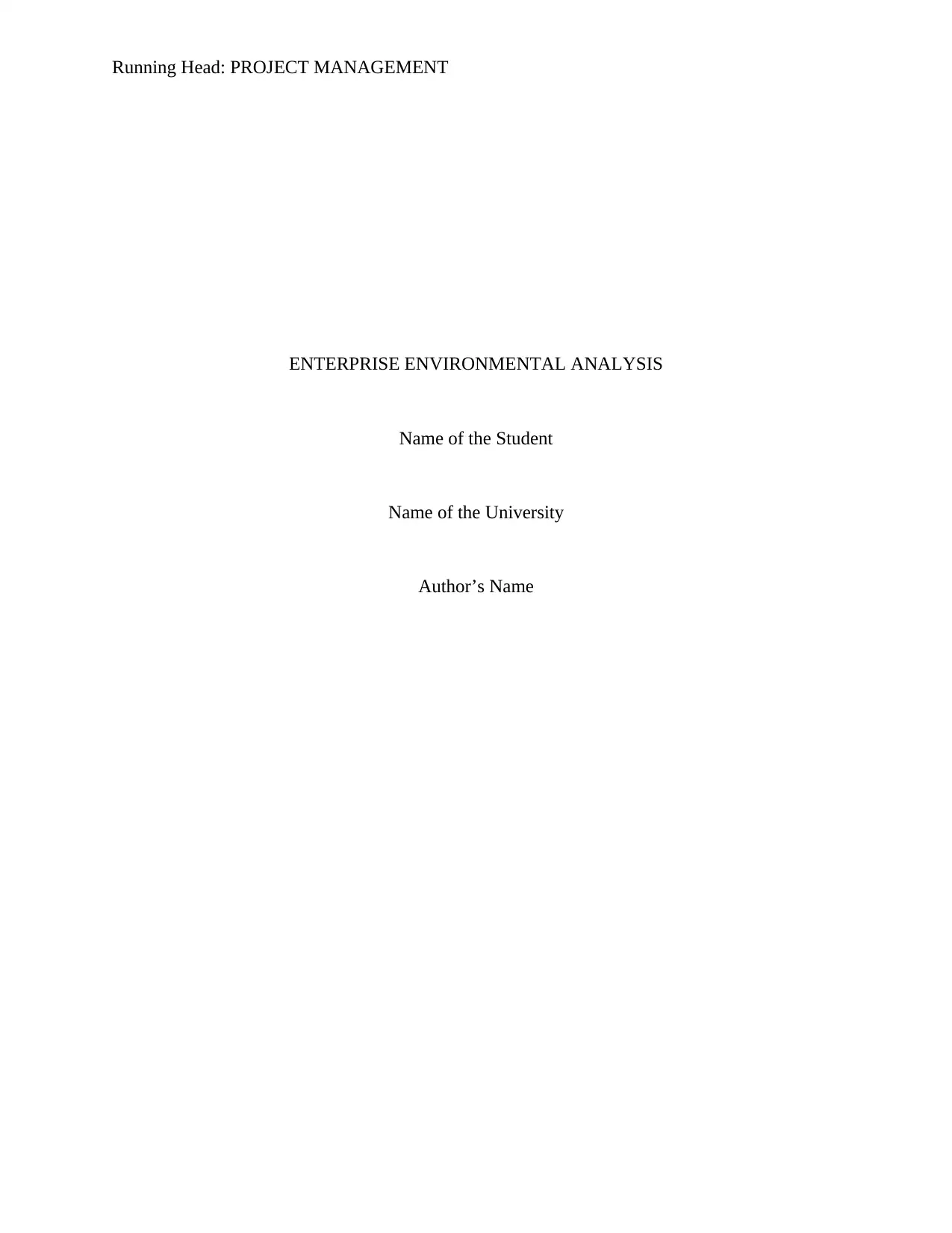
Running Head: PROJECT MANAGEMENT
ENTERPRISE ENVIRONMENTAL ANALYSIS
Name of the Student
Name of the University
Author’s Name
ENTERPRISE ENVIRONMENTAL ANALYSIS
Name of the Student
Name of the University
Author’s Name
Paraphrase This Document
Need a fresh take? Get an instant paraphrase of this document with our AI Paraphraser
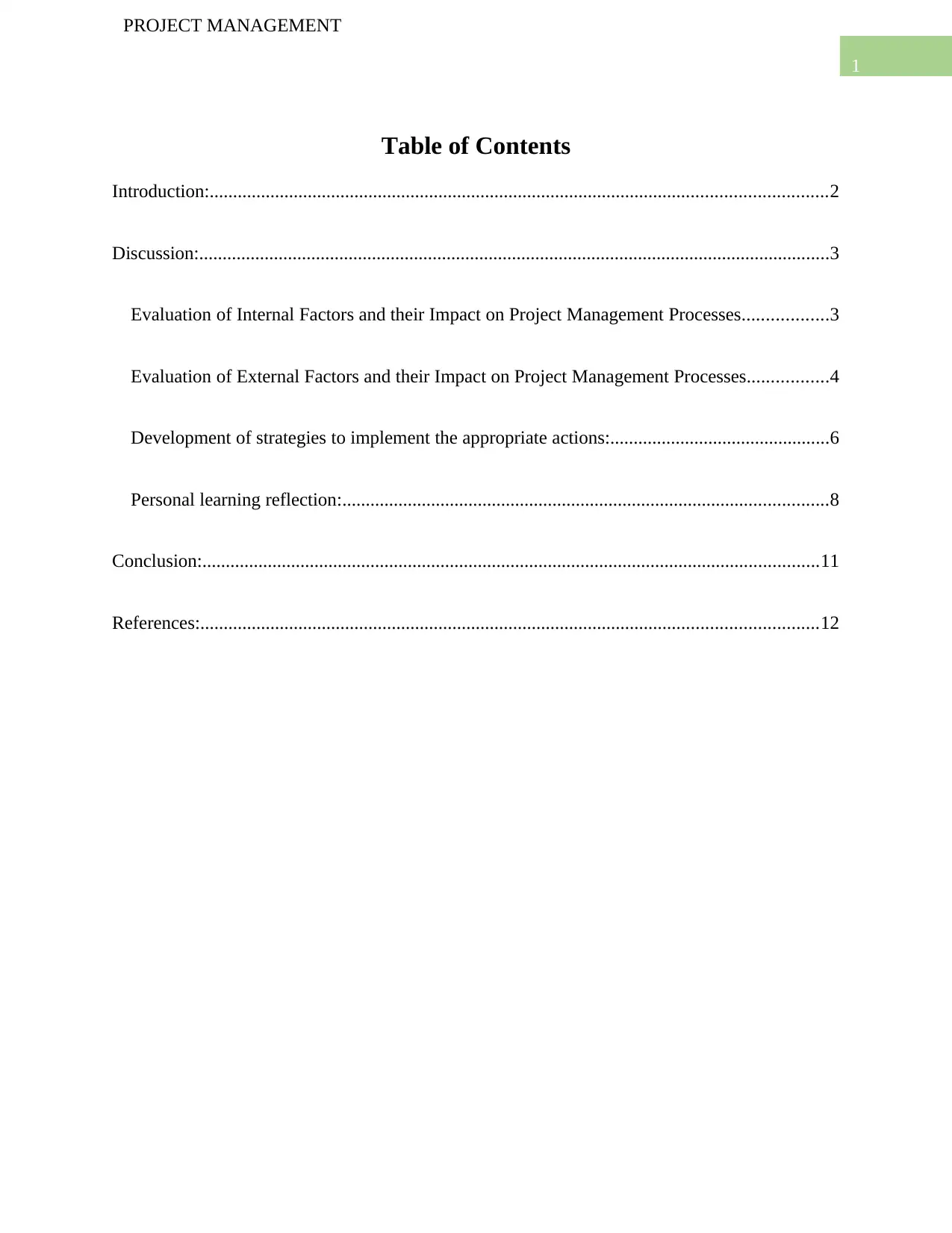
1
PROJECT MANAGEMENT
Table of Contents
Introduction:....................................................................................................................................2
Discussion:.......................................................................................................................................3
Evaluation of Internal Factors and their Impact on Project Management Processes..................3
Evaluation of External Factors and their Impact on Project Management Processes.................4
Development of strategies to implement the appropriate actions:...............................................6
Personal learning reflection:........................................................................................................8
Conclusion:....................................................................................................................................11
References:....................................................................................................................................12
PROJECT MANAGEMENT
Table of Contents
Introduction:....................................................................................................................................2
Discussion:.......................................................................................................................................3
Evaluation of Internal Factors and their Impact on Project Management Processes..................3
Evaluation of External Factors and their Impact on Project Management Processes.................4
Development of strategies to implement the appropriate actions:...............................................6
Personal learning reflection:........................................................................................................8
Conclusion:....................................................................................................................................11
References:....................................................................................................................................12
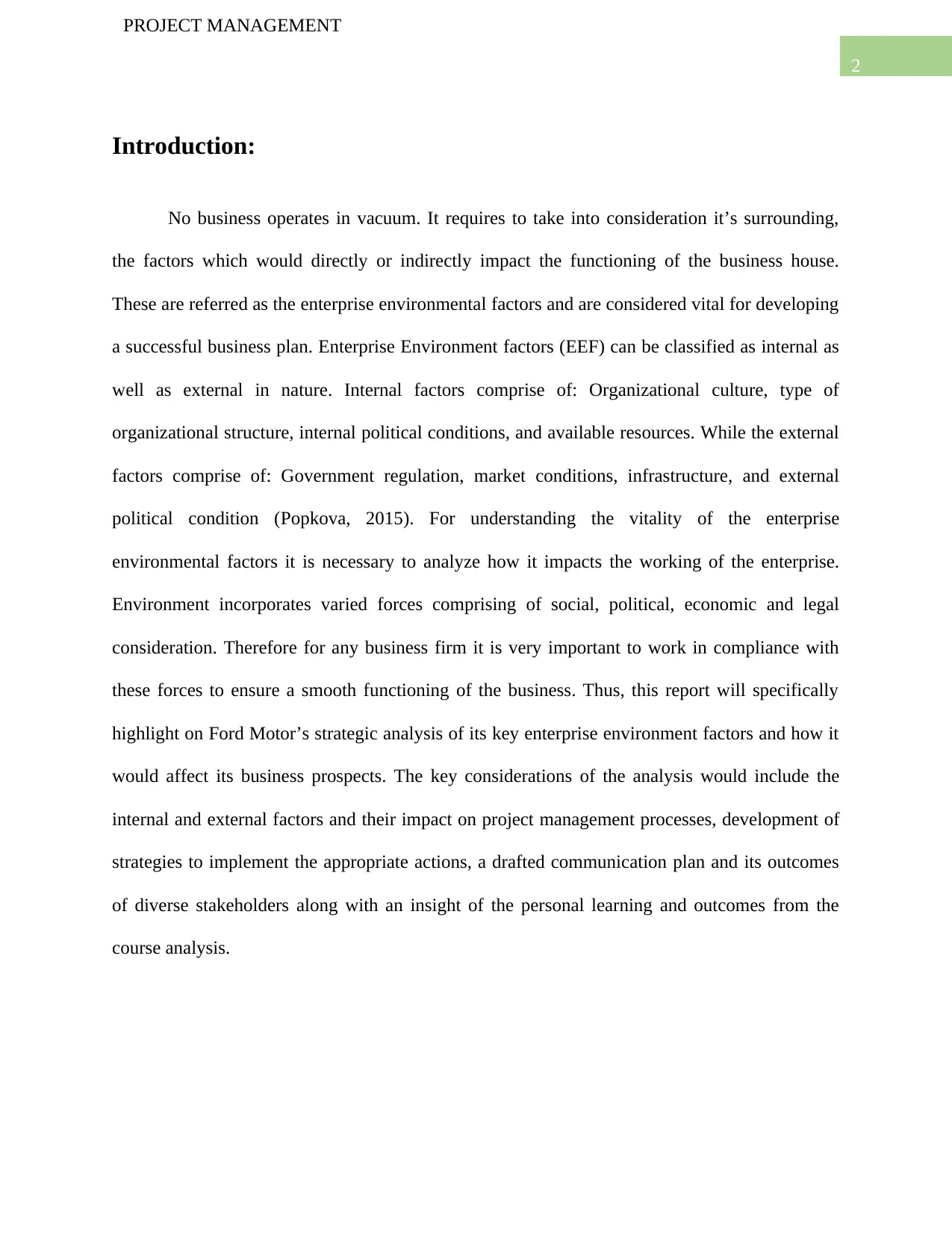
2
PROJECT MANAGEMENT
Introduction:
No business operates in vacuum. It requires to take into consideration it’s surrounding,
the factors which would directly or indirectly impact the functioning of the business house.
These are referred as the enterprise environmental factors and are considered vital for developing
a successful business plan. Enterprise Environment factors (EEF) can be classified as internal as
well as external in nature. Internal factors comprise of: Organizational culture, type of
organizational structure, internal political conditions, and available resources. While the external
factors comprise of: Government regulation, market conditions, infrastructure, and external
political condition (Popkova, 2015). For understanding the vitality of the enterprise
environmental factors it is necessary to analyze how it impacts the working of the enterprise.
Environment incorporates varied forces comprising of social, political, economic and legal
consideration. Therefore for any business firm it is very important to work in compliance with
these forces to ensure a smooth functioning of the business. Thus, this report will specifically
highlight on Ford Motor’s strategic analysis of its key enterprise environment factors and how it
would affect its business prospects. The key considerations of the analysis would include the
internal and external factors and their impact on project management processes, development of
strategies to implement the appropriate actions, a drafted communication plan and its outcomes
of diverse stakeholders along with an insight of the personal learning and outcomes from the
course analysis.
PROJECT MANAGEMENT
Introduction:
No business operates in vacuum. It requires to take into consideration it’s surrounding,
the factors which would directly or indirectly impact the functioning of the business house.
These are referred as the enterprise environmental factors and are considered vital for developing
a successful business plan. Enterprise Environment factors (EEF) can be classified as internal as
well as external in nature. Internal factors comprise of: Organizational culture, type of
organizational structure, internal political conditions, and available resources. While the external
factors comprise of: Government regulation, market conditions, infrastructure, and external
political condition (Popkova, 2015). For understanding the vitality of the enterprise
environmental factors it is necessary to analyze how it impacts the working of the enterprise.
Environment incorporates varied forces comprising of social, political, economic and legal
consideration. Therefore for any business firm it is very important to work in compliance with
these forces to ensure a smooth functioning of the business. Thus, this report will specifically
highlight on Ford Motor’s strategic analysis of its key enterprise environment factors and how it
would affect its business prospects. The key considerations of the analysis would include the
internal and external factors and their impact on project management processes, development of
strategies to implement the appropriate actions, a drafted communication plan and its outcomes
of diverse stakeholders along with an insight of the personal learning and outcomes from the
course analysis.
⊘ This is a preview!⊘
Do you want full access?
Subscribe today to unlock all pages.

Trusted by 1+ million students worldwide
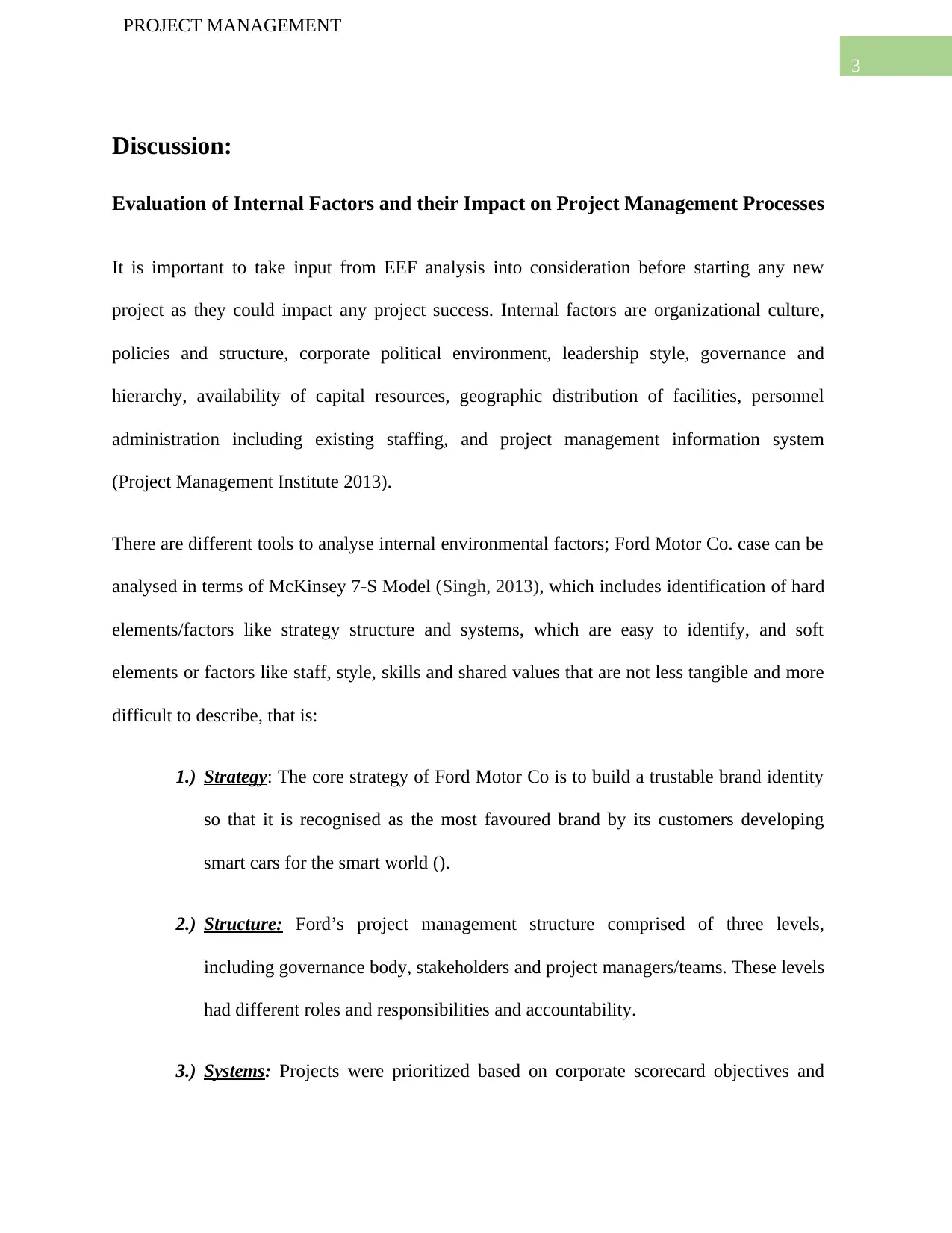
3
PROJECT MANAGEMENT
Discussion:
Evaluation of Internal Factors and their Impact on Project Management Processes
It is important to take input from EEF analysis into consideration before starting any new
project as they could impact any project success. Internal factors are organizational culture,
policies and structure, corporate political environment, leadership style, governance and
hierarchy, availability of capital resources, geographic distribution of facilities, personnel
administration including existing staffing, and project management information system
(Project Management Institute 2013).
There are different tools to analyse internal environmental factors; Ford Motor Co. case can be
analysed in terms of McKinsey 7-S Model (Singh, 2013), which includes identification of hard
elements/factors like strategy structure and systems, which are easy to identify, and soft
elements or factors like staff, style, skills and shared values that are not less tangible and more
difficult to describe, that is:
1.) Strategy: The core strategy of Ford Motor Co is to build a trustable brand identity
so that it is recognised as the most favoured brand by its customers developing
smart cars for the smart world ().
2.) Structure: Ford’s project management structure comprised of three levels,
including governance body, stakeholders and project managers/teams. These levels
had different roles and responsibilities and accountability.
3.) Systems: Projects were prioritized based on corporate scorecard objectives and
PROJECT MANAGEMENT
Discussion:
Evaluation of Internal Factors and their Impact on Project Management Processes
It is important to take input from EEF analysis into consideration before starting any new
project as they could impact any project success. Internal factors are organizational culture,
policies and structure, corporate political environment, leadership style, governance and
hierarchy, availability of capital resources, geographic distribution of facilities, personnel
administration including existing staffing, and project management information system
(Project Management Institute 2013).
There are different tools to analyse internal environmental factors; Ford Motor Co. case can be
analysed in terms of McKinsey 7-S Model (Singh, 2013), which includes identification of hard
elements/factors like strategy structure and systems, which are easy to identify, and soft
elements or factors like staff, style, skills and shared values that are not less tangible and more
difficult to describe, that is:
1.) Strategy: The core strategy of Ford Motor Co is to build a trustable brand identity
so that it is recognised as the most favoured brand by its customers developing
smart cars for the smart world ().
2.) Structure: Ford’s project management structure comprised of three levels,
including governance body, stakeholders and project managers/teams. These levels
had different roles and responsibilities and accountability.
3.) Systems: Projects were prioritized based on corporate scorecard objectives and
Paraphrase This Document
Need a fresh take? Get an instant paraphrase of this document with our AI Paraphraser
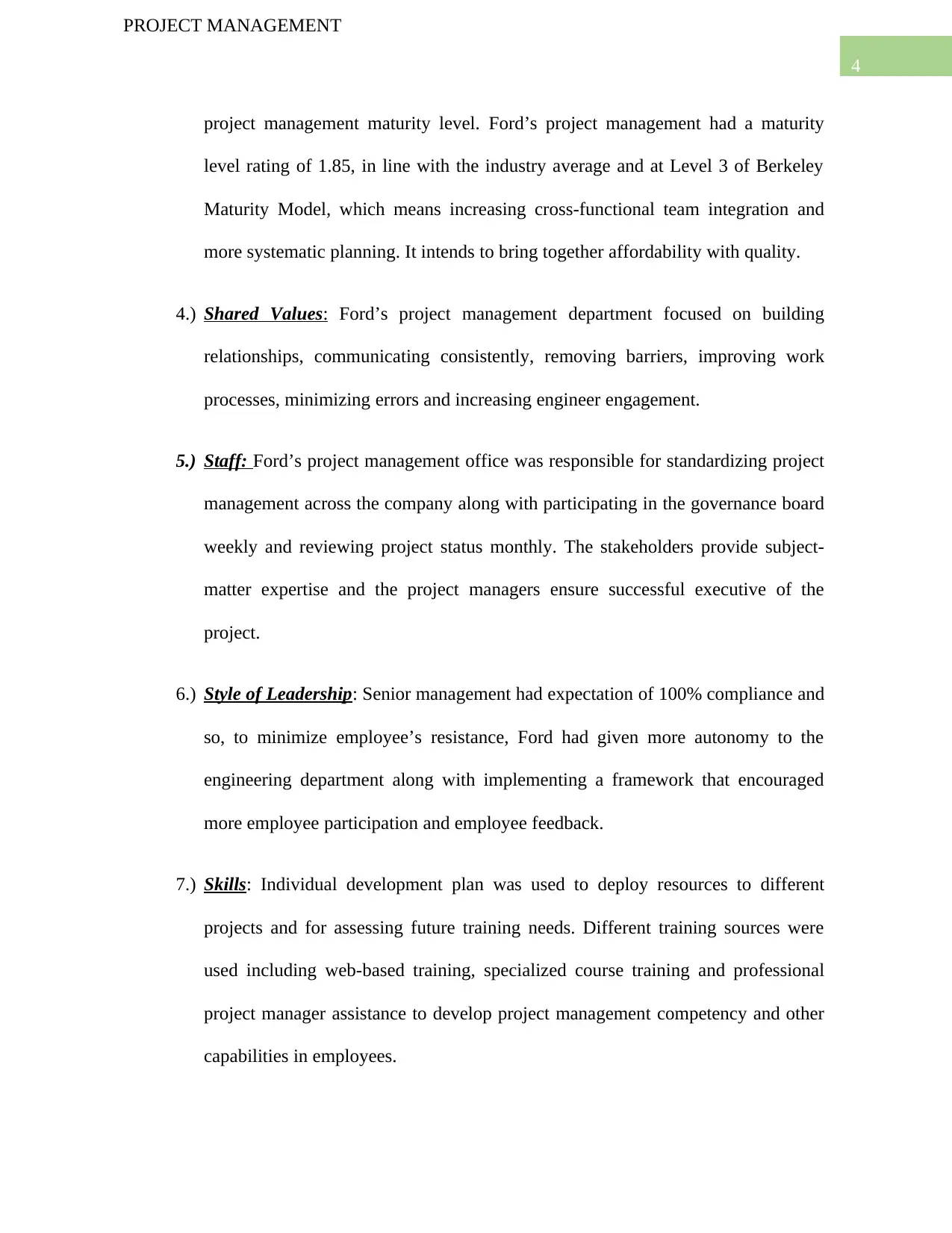
4
PROJECT MANAGEMENT
project management maturity level. Ford’s project management had a maturity
level rating of 1.85, in line with the industry average and at Level 3 of Berkeley
Maturity Model, which means increasing cross-functional team integration and
more systematic planning. It intends to bring together affordability with quality.
4.) Shared Values: Ford’s project management department focused on building
relationships, communicating consistently, removing barriers, improving work
processes, minimizing errors and increasing engineer engagement.
5.) Staff: Ford’s project management office was responsible for standardizing project
management across the company along with participating in the governance board
weekly and reviewing project status monthly. The stakeholders provide subject-
matter expertise and the project managers ensure successful executive of the
project.
6.) Style of Leadership: Senior management had expectation of 100% compliance and
so, to minimize employee’s resistance, Ford had given more autonomy to the
engineering department along with implementing a framework that encouraged
more employee participation and employee feedback.
7.) Skills: Individual development plan was used to deploy resources to different
projects and for assessing future training needs. Different training sources were
used including web-based training, specialized course training and professional
project manager assistance to develop project management competency and other
capabilities in employees.
PROJECT MANAGEMENT
project management maturity level. Ford’s project management had a maturity
level rating of 1.85, in line with the industry average and at Level 3 of Berkeley
Maturity Model, which means increasing cross-functional team integration and
more systematic planning. It intends to bring together affordability with quality.
4.) Shared Values: Ford’s project management department focused on building
relationships, communicating consistently, removing barriers, improving work
processes, minimizing errors and increasing engineer engagement.
5.) Staff: Ford’s project management office was responsible for standardizing project
management across the company along with participating in the governance board
weekly and reviewing project status monthly. The stakeholders provide subject-
matter expertise and the project managers ensure successful executive of the
project.
6.) Style of Leadership: Senior management had expectation of 100% compliance and
so, to minimize employee’s resistance, Ford had given more autonomy to the
engineering department along with implementing a framework that encouraged
more employee participation and employee feedback.
7.) Skills: Individual development plan was used to deploy resources to different
projects and for assessing future training needs. Different training sources were
used including web-based training, specialized course training and professional
project manager assistance to develop project management competency and other
capabilities in employees.
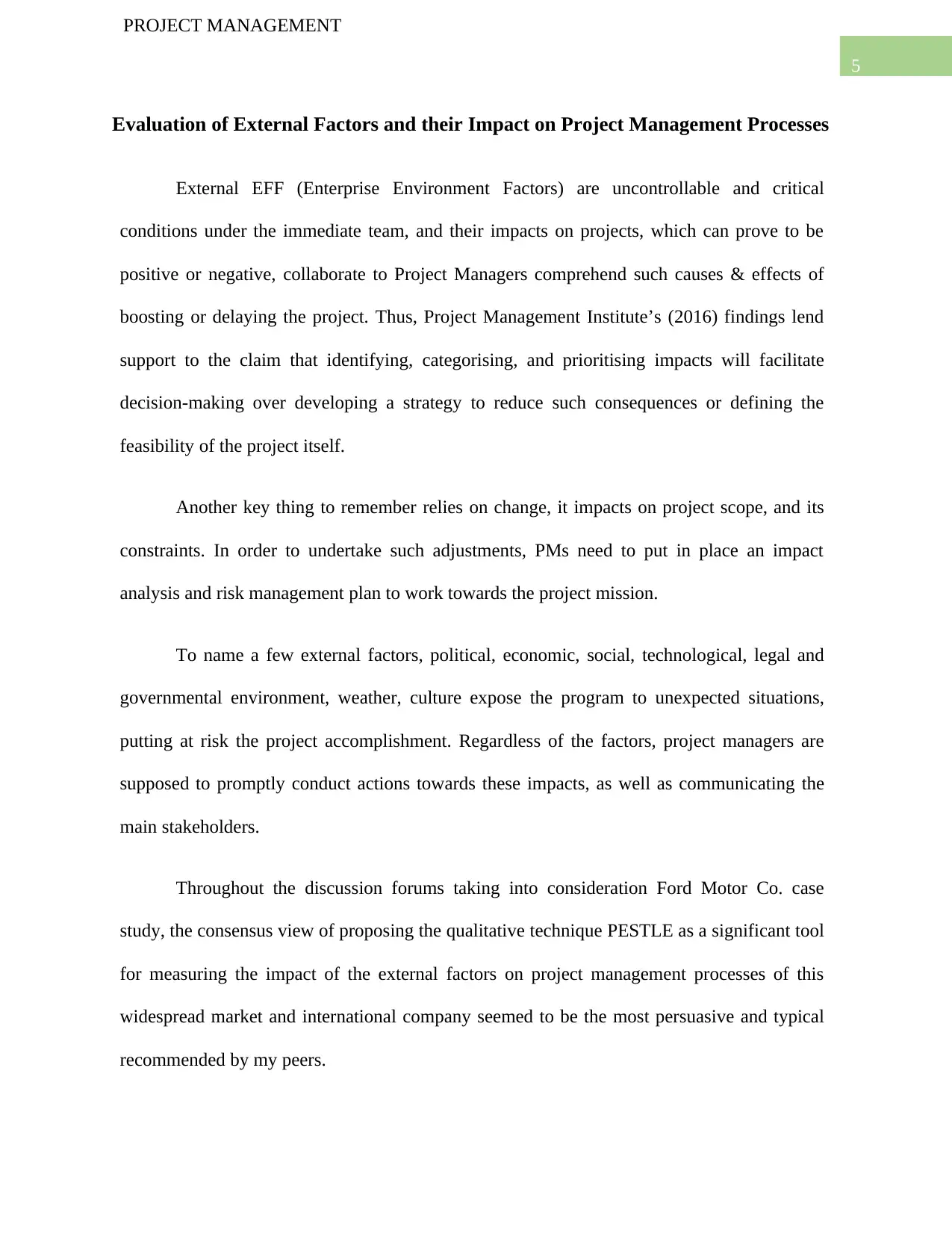
5
PROJECT MANAGEMENT
Evaluation of External Factors and their Impact on Project Management Processes
External EFF (Enterprise Environment Factors) are uncontrollable and critical
conditions under the immediate team, and their impacts on projects, which can prove to be
positive or negative, collaborate to Project Managers comprehend such causes & effects of
boosting or delaying the project. Thus, Project Management Institute’s (2016) findings lend
support to the claim that identifying, categorising, and prioritising impacts will facilitate
decision-making over developing a strategy to reduce such consequences or defining the
feasibility of the project itself.
Another key thing to remember relies on change, it impacts on project scope, and its
constraints. In order to undertake such adjustments, PMs need to put in place an impact
analysis and risk management plan to work towards the project mission.
To name a few external factors, political, economic, social, technological, legal and
governmental environment, weather, culture expose the program to unexpected situations,
putting at risk the project accomplishment. Regardless of the factors, project managers are
supposed to promptly conduct actions towards these impacts, as well as communicating the
main stakeholders.
Throughout the discussion forums taking into consideration Ford Motor Co. case
study, the consensus view of proposing the qualitative technique PESTLE as a significant tool
for measuring the impact of the external factors on project management processes of this
widespread market and international company seemed to be the most persuasive and typical
recommended by my peers.
PROJECT MANAGEMENT
Evaluation of External Factors and their Impact on Project Management Processes
External EFF (Enterprise Environment Factors) are uncontrollable and critical
conditions under the immediate team, and their impacts on projects, which can prove to be
positive or negative, collaborate to Project Managers comprehend such causes & effects of
boosting or delaying the project. Thus, Project Management Institute’s (2016) findings lend
support to the claim that identifying, categorising, and prioritising impacts will facilitate
decision-making over developing a strategy to reduce such consequences or defining the
feasibility of the project itself.
Another key thing to remember relies on change, it impacts on project scope, and its
constraints. In order to undertake such adjustments, PMs need to put in place an impact
analysis and risk management plan to work towards the project mission.
To name a few external factors, political, economic, social, technological, legal and
governmental environment, weather, culture expose the program to unexpected situations,
putting at risk the project accomplishment. Regardless of the factors, project managers are
supposed to promptly conduct actions towards these impacts, as well as communicating the
main stakeholders.
Throughout the discussion forums taking into consideration Ford Motor Co. case
study, the consensus view of proposing the qualitative technique PESTLE as a significant tool
for measuring the impact of the external factors on project management processes of this
widespread market and international company seemed to be the most persuasive and typical
recommended by my peers.
⊘ This is a preview!⊘
Do you want full access?
Subscribe today to unlock all pages.

Trusted by 1+ million students worldwide
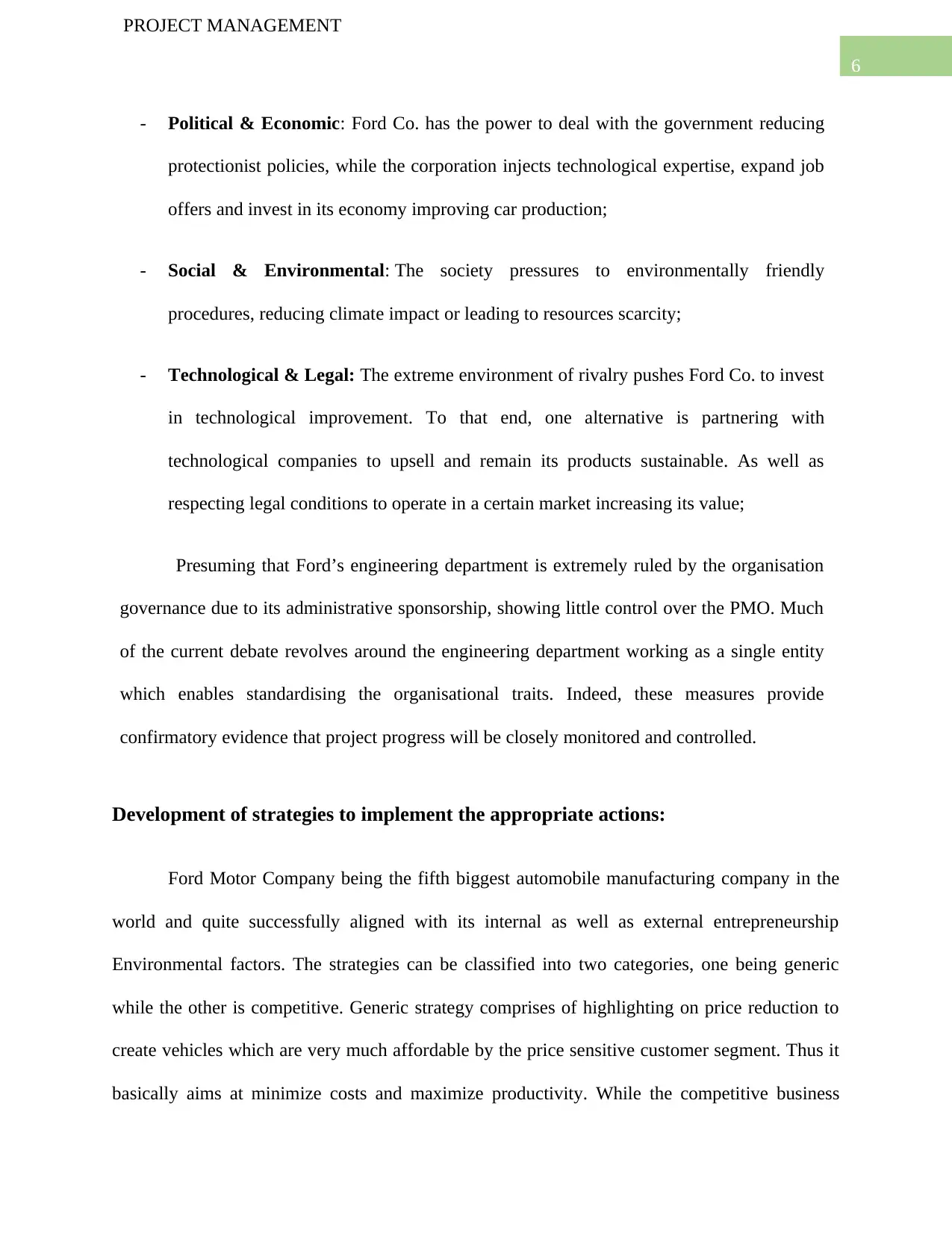
6
PROJECT MANAGEMENT
- Political & Economic: Ford Co. has the power to deal with the government reducing
protectionist policies, while the corporation injects technological expertise, expand job
offers and invest in its economy improving car production;
- Social & Environmental: The society pressures to environmentally friendly
procedures, reducing climate impact or leading to resources scarcity;
- Technological & Legal: The extreme environment of rivalry pushes Ford Co. to invest
in technological improvement. To that end, one alternative is partnering with
technological companies to upsell and remain its products sustainable. As well as
respecting legal conditions to operate in a certain market increasing its value;
Presuming that Ford’s engineering department is extremely ruled by the organisation
governance due to its administrative sponsorship, showing little control over the PMO. Much
of the current debate revolves around the engineering department working as a single entity
which enables standardising the organisational traits. Indeed, these measures provide
confirmatory evidence that project progress will be closely monitored and controlled.
Development of strategies to implement the appropriate actions:
Ford Motor Company being the fifth biggest automobile manufacturing company in the
world and quite successfully aligned with its internal as well as external entrepreneurship
Environmental factors. The strategies can be classified into two categories, one being generic
while the other is competitive. Generic strategy comprises of highlighting on price reduction to
create vehicles which are very much affordable by the price sensitive customer segment. Thus it
basically aims at minimize costs and maximize productivity. While the competitive business
PROJECT MANAGEMENT
- Political & Economic: Ford Co. has the power to deal with the government reducing
protectionist policies, while the corporation injects technological expertise, expand job
offers and invest in its economy improving car production;
- Social & Environmental: The society pressures to environmentally friendly
procedures, reducing climate impact or leading to resources scarcity;
- Technological & Legal: The extreme environment of rivalry pushes Ford Co. to invest
in technological improvement. To that end, one alternative is partnering with
technological companies to upsell and remain its products sustainable. As well as
respecting legal conditions to operate in a certain market increasing its value;
Presuming that Ford’s engineering department is extremely ruled by the organisation
governance due to its administrative sponsorship, showing little control over the PMO. Much
of the current debate revolves around the engineering department working as a single entity
which enables standardising the organisational traits. Indeed, these measures provide
confirmatory evidence that project progress will be closely monitored and controlled.
Development of strategies to implement the appropriate actions:
Ford Motor Company being the fifth biggest automobile manufacturing company in the
world and quite successfully aligned with its internal as well as external entrepreneurship
Environmental factors. The strategies can be classified into two categories, one being generic
while the other is competitive. Generic strategy comprises of highlighting on price reduction to
create vehicles which are very much affordable by the price sensitive customer segment. Thus it
basically aims at minimize costs and maximize productivity. While the competitive business
Paraphrase This Document
Need a fresh take? Get an instant paraphrase of this document with our AI Paraphraser
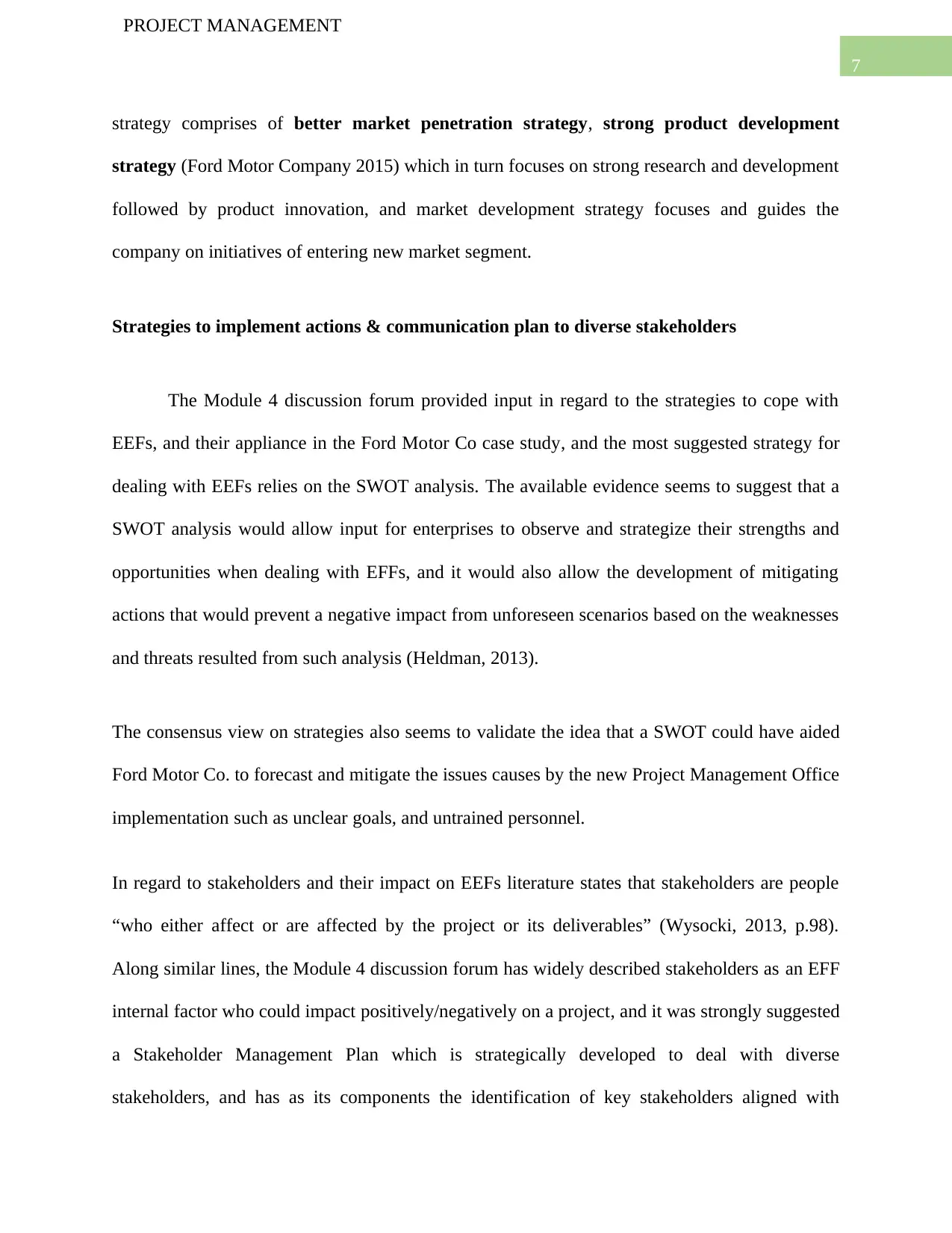
7
PROJECT MANAGEMENT
strategy comprises of better market penetration strategy, strong product development
strategy (Ford Motor Company 2015) which in turn focuses on strong research and development
followed by product innovation, and market development strategy focuses and guides the
company on initiatives of entering new market segment.
Strategies to implement actions & communication plan to diverse stakeholders
The Module 4 discussion forum provided input in regard to the strategies to cope with
EEFs, and their appliance in the Ford Motor Co case study, and the most suggested strategy for
dealing with EEFs relies on the SWOT analysis. The available evidence seems to suggest that a
SWOT analysis would allow input for enterprises to observe and strategize their strengths and
opportunities when dealing with EFFs, and it would also allow the development of mitigating
actions that would prevent a negative impact from unforeseen scenarios based on the weaknesses
and threats resulted from such analysis (Heldman, 2013).
The consensus view on strategies also seems to validate the idea that a SWOT could have aided
Ford Motor Co. to forecast and mitigate the issues causes by the new Project Management Office
implementation such as unclear goals, and untrained personnel.
In regard to stakeholders and their impact on EEFs literature states that stakeholders are people
“who either affect or are affected by the project or its deliverables” (Wysocki, 2013, p.98).
Along similar lines, the Module 4 discussion forum has widely described stakeholders as an EFF
internal factor who could impact positively/negatively on a project, and it was strongly suggested
a Stakeholder Management Plan which is strategically developed to deal with diverse
stakeholders, and has as its components the identification of key stakeholders aligned with
PROJECT MANAGEMENT
strategy comprises of better market penetration strategy, strong product development
strategy (Ford Motor Company 2015) which in turn focuses on strong research and development
followed by product innovation, and market development strategy focuses and guides the
company on initiatives of entering new market segment.
Strategies to implement actions & communication plan to diverse stakeholders
The Module 4 discussion forum provided input in regard to the strategies to cope with
EEFs, and their appliance in the Ford Motor Co case study, and the most suggested strategy for
dealing with EEFs relies on the SWOT analysis. The available evidence seems to suggest that a
SWOT analysis would allow input for enterprises to observe and strategize their strengths and
opportunities when dealing with EFFs, and it would also allow the development of mitigating
actions that would prevent a negative impact from unforeseen scenarios based on the weaknesses
and threats resulted from such analysis (Heldman, 2013).
The consensus view on strategies also seems to validate the idea that a SWOT could have aided
Ford Motor Co. to forecast and mitigate the issues causes by the new Project Management Office
implementation such as unclear goals, and untrained personnel.
In regard to stakeholders and their impact on EEFs literature states that stakeholders are people
“who either affect or are affected by the project or its deliverables” (Wysocki, 2013, p.98).
Along similar lines, the Module 4 discussion forum has widely described stakeholders as an EFF
internal factor who could impact positively/negatively on a project, and it was strongly suggested
a Stakeholder Management Plan which is strategically developed to deal with diverse
stakeholders, and has as its components the identification of key stakeholders aligned with
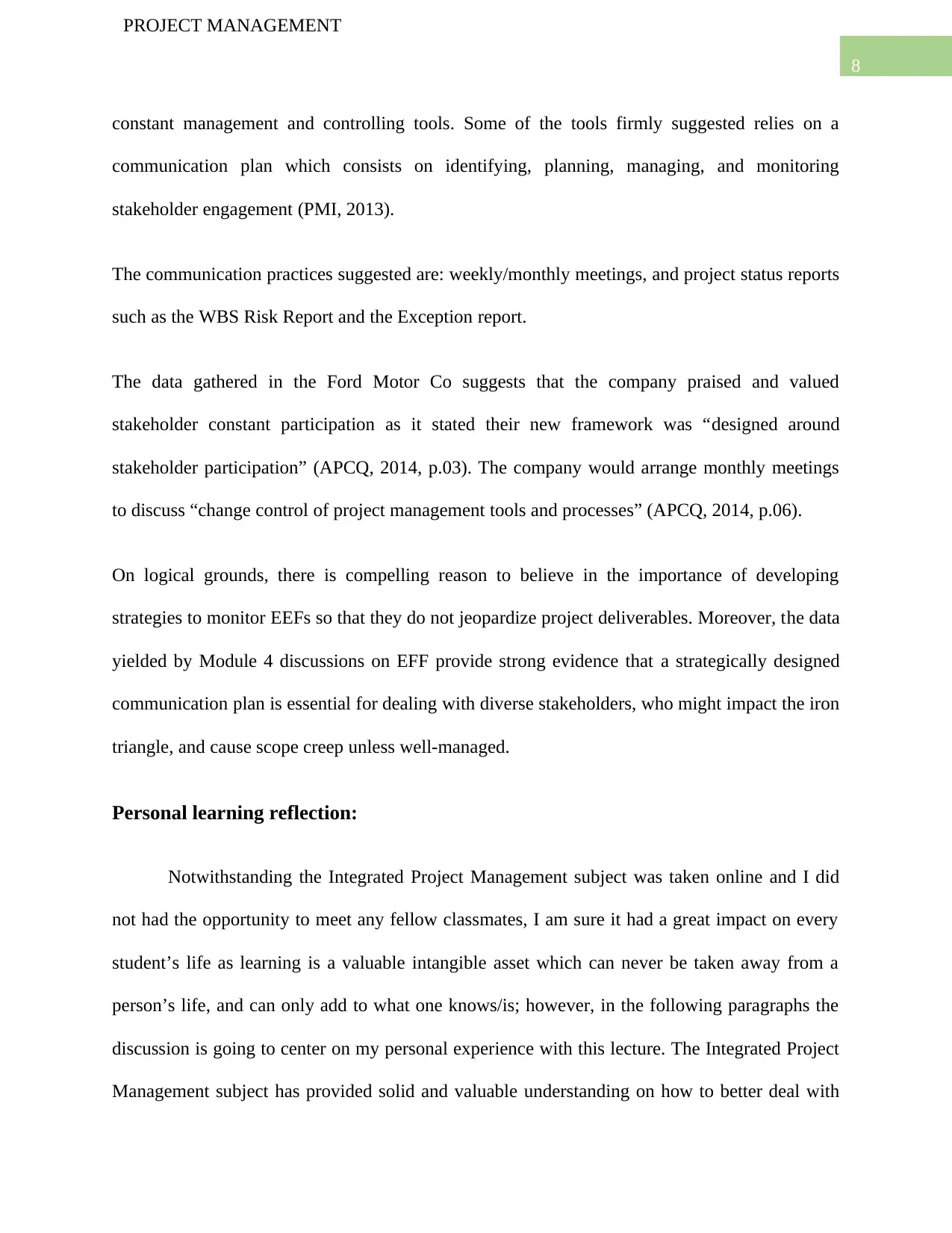
8
PROJECT MANAGEMENT
constant management and controlling tools. Some of the tools firmly suggested relies on a
communication plan which consists on identifying, planning, managing, and monitoring
stakeholder engagement (PMI, 2013).
The communication practices suggested are: weekly/monthly meetings, and project status reports
such as the WBS Risk Report and the Exception report.
The data gathered in the Ford Motor Co suggests that the company praised and valued
stakeholder constant participation as it stated their new framework was “designed around
stakeholder participation” (APCQ, 2014, p.03). The company would arrange monthly meetings
to discuss “change control of project management tools and processes” (APCQ, 2014, p.06).
On logical grounds, there is compelling reason to believe in the importance of developing
strategies to monitor EEFs so that they do not jeopardize project deliverables. Moreover, the data
yielded by Module 4 discussions on EFF provide strong evidence that a strategically designed
communication plan is essential for dealing with diverse stakeholders, who might impact the iron
triangle, and cause scope creep unless well-managed.
Personal learning reflection:
Notwithstanding the Integrated Project Management subject was taken online and I did
not had the opportunity to meet any fellow classmates, I am sure it had a great impact on every
student’s life as learning is a valuable intangible asset which can never be taken away from a
person’s life, and can only add to what one knows/is; however, in the following paragraphs the
discussion is going to center on my personal experience with this lecture. The Integrated Project
Management subject has provided solid and valuable understanding on how to better deal with
PROJECT MANAGEMENT
constant management and controlling tools. Some of the tools firmly suggested relies on a
communication plan which consists on identifying, planning, managing, and monitoring
stakeholder engagement (PMI, 2013).
The communication practices suggested are: weekly/monthly meetings, and project status reports
such as the WBS Risk Report and the Exception report.
The data gathered in the Ford Motor Co suggests that the company praised and valued
stakeholder constant participation as it stated their new framework was “designed around
stakeholder participation” (APCQ, 2014, p.03). The company would arrange monthly meetings
to discuss “change control of project management tools and processes” (APCQ, 2014, p.06).
On logical grounds, there is compelling reason to believe in the importance of developing
strategies to monitor EEFs so that they do not jeopardize project deliverables. Moreover, the data
yielded by Module 4 discussions on EFF provide strong evidence that a strategically designed
communication plan is essential for dealing with diverse stakeholders, who might impact the iron
triangle, and cause scope creep unless well-managed.
Personal learning reflection:
Notwithstanding the Integrated Project Management subject was taken online and I did
not had the opportunity to meet any fellow classmates, I am sure it had a great impact on every
student’s life as learning is a valuable intangible asset which can never be taken away from a
person’s life, and can only add to what one knows/is; however, in the following paragraphs the
discussion is going to center on my personal experience with this lecture. The Integrated Project
Management subject has provided solid and valuable understanding on how to better deal with
⊘ This is a preview!⊘
Do you want full access?
Subscribe today to unlock all pages.

Trusted by 1+ million students worldwide
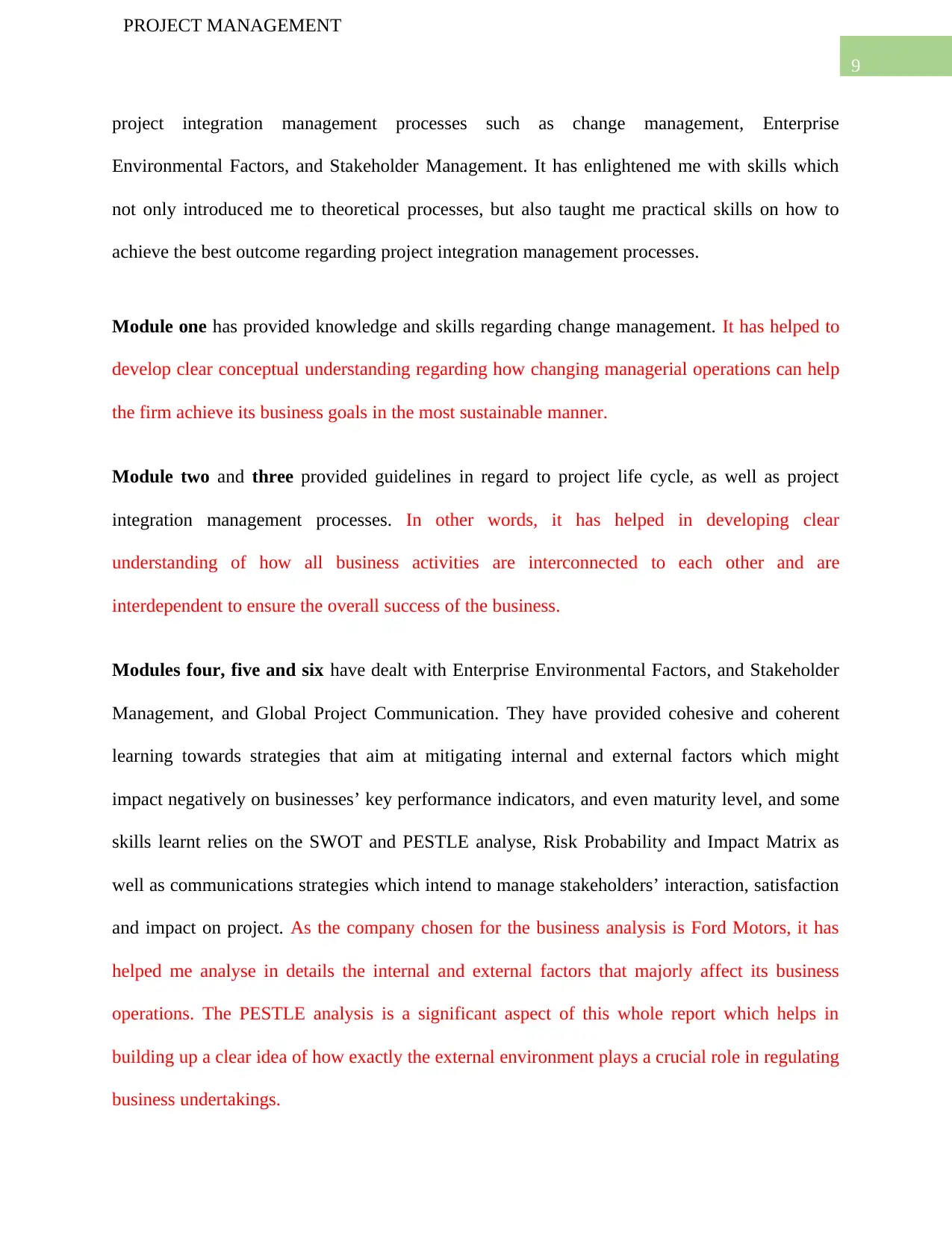
9
PROJECT MANAGEMENT
project integration management processes such as change management, Enterprise
Environmental Factors, and Stakeholder Management. It has enlightened me with skills which
not only introduced me to theoretical processes, but also taught me practical skills on how to
achieve the best outcome regarding project integration management processes.
Module one has provided knowledge and skills regarding change management. It has helped to
develop clear conceptual understanding regarding how changing managerial operations can help
the firm achieve its business goals in the most sustainable manner.
Module two and three provided guidelines in regard to project life cycle, as well as project
integration management processes. In other words, it has helped in developing clear
understanding of how all business activities are interconnected to each other and are
interdependent to ensure the overall success of the business.
Modules four, five and six have dealt with Enterprise Environmental Factors, and Stakeholder
Management, and Global Project Communication. They have provided cohesive and coherent
learning towards strategies that aim at mitigating internal and external factors which might
impact negatively on businesses’ key performance indicators, and even maturity level, and some
skills learnt relies on the SWOT and PESTLE analyse, Risk Probability and Impact Matrix as
well as communications strategies which intend to manage stakeholders’ interaction, satisfaction
and impact on project. As the company chosen for the business analysis is Ford Motors, it has
helped me analyse in details the internal and external factors that majorly affect its business
operations. The PESTLE analysis is a significant aspect of this whole report which helps in
building up a clear idea of how exactly the external environment plays a crucial role in regulating
business undertakings.
PROJECT MANAGEMENT
project integration management processes such as change management, Enterprise
Environmental Factors, and Stakeholder Management. It has enlightened me with skills which
not only introduced me to theoretical processes, but also taught me practical skills on how to
achieve the best outcome regarding project integration management processes.
Module one has provided knowledge and skills regarding change management. It has helped to
develop clear conceptual understanding regarding how changing managerial operations can help
the firm achieve its business goals in the most sustainable manner.
Module two and three provided guidelines in regard to project life cycle, as well as project
integration management processes. In other words, it has helped in developing clear
understanding of how all business activities are interconnected to each other and are
interdependent to ensure the overall success of the business.
Modules four, five and six have dealt with Enterprise Environmental Factors, and Stakeholder
Management, and Global Project Communication. They have provided cohesive and coherent
learning towards strategies that aim at mitigating internal and external factors which might
impact negatively on businesses’ key performance indicators, and even maturity level, and some
skills learnt relies on the SWOT and PESTLE analyse, Risk Probability and Impact Matrix as
well as communications strategies which intend to manage stakeholders’ interaction, satisfaction
and impact on project. As the company chosen for the business analysis is Ford Motors, it has
helped me analyse in details the internal and external factors that majorly affect its business
operations. The PESTLE analysis is a significant aspect of this whole report which helps in
building up a clear idea of how exactly the external environment plays a crucial role in regulating
business undertakings.
Paraphrase This Document
Need a fresh take? Get an instant paraphrase of this document with our AI Paraphraser
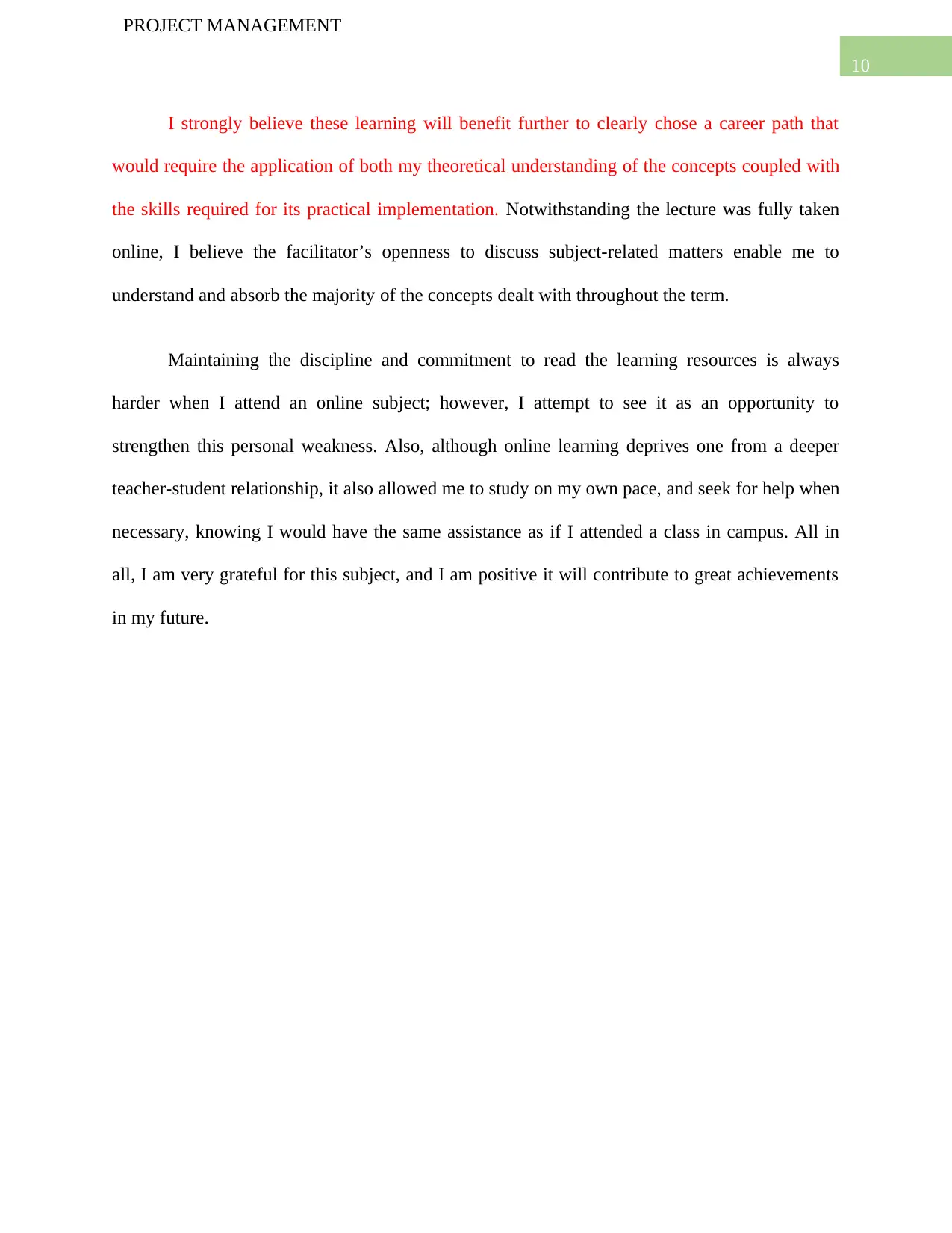
10
PROJECT MANAGEMENT
I strongly believe these learning will benefit further to clearly chose a career path that
would require the application of both my theoretical understanding of the concepts coupled with
the skills required for its practical implementation. Notwithstanding the lecture was fully taken
online, I believe the facilitator’s openness to discuss subject-related matters enable me to
understand and absorb the majority of the concepts dealt with throughout the term.
Maintaining the discipline and commitment to read the learning resources is always
harder when I attend an online subject; however, I attempt to see it as an opportunity to
strengthen this personal weakness. Also, although online learning deprives one from a deeper
teacher-student relationship, it also allowed me to study on my own pace, and seek for help when
necessary, knowing I would have the same assistance as if I attended a class in campus. All in
all, I am very grateful for this subject, and I am positive it will contribute to great achievements
in my future.
PROJECT MANAGEMENT
I strongly believe these learning will benefit further to clearly chose a career path that
would require the application of both my theoretical understanding of the concepts coupled with
the skills required for its practical implementation. Notwithstanding the lecture was fully taken
online, I believe the facilitator’s openness to discuss subject-related matters enable me to
understand and absorb the majority of the concepts dealt with throughout the term.
Maintaining the discipline and commitment to read the learning resources is always
harder when I attend an online subject; however, I attempt to see it as an opportunity to
strengthen this personal weakness. Also, although online learning deprives one from a deeper
teacher-student relationship, it also allowed me to study on my own pace, and seek for help when
necessary, knowing I would have the same assistance as if I attended a class in campus. All in
all, I am very grateful for this subject, and I am positive it will contribute to great achievements
in my future.
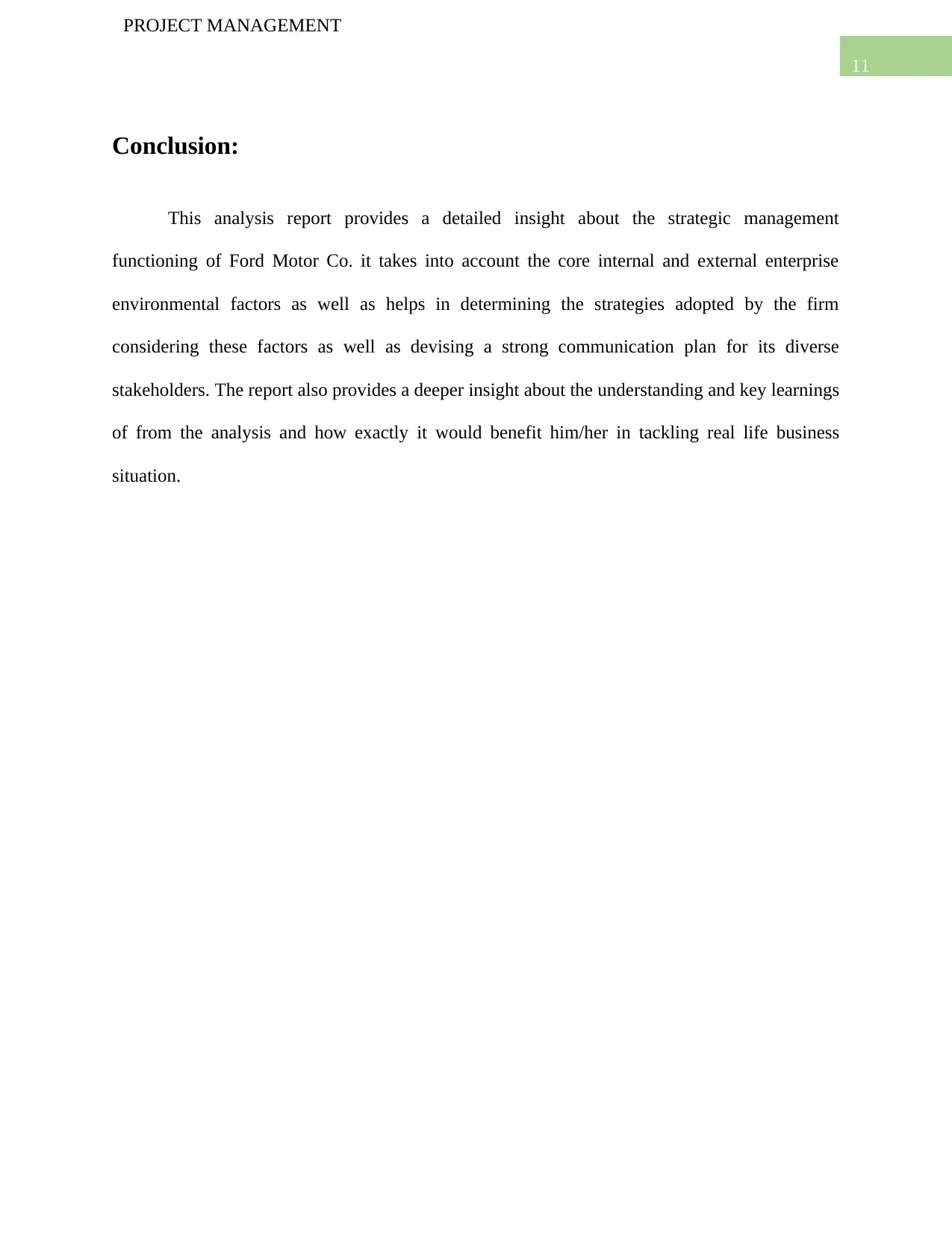
11
PROJECT MANAGEMENT
Conclusion:
This analysis report provides a detailed insight about the strategic management
functioning of Ford Motor Co. it takes into account the core internal and external enterprise
environmental factors as well as helps in determining the strategies adopted by the firm
considering these factors as well as devising a strong communication plan for its diverse
stakeholders. The report also provides a deeper insight about the understanding and key learnings
of from the analysis and how exactly it would benefit him/her in tackling real life business
situation.
PROJECT MANAGEMENT
Conclusion:
This analysis report provides a detailed insight about the strategic management
functioning of Ford Motor Co. it takes into account the core internal and external enterprise
environmental factors as well as helps in determining the strategies adopted by the firm
considering these factors as well as devising a strong communication plan for its diverse
stakeholders. The report also provides a deeper insight about the understanding and key learnings
of from the analysis and how exactly it would benefit him/her in tackling real life business
situation.
⊘ This is a preview!⊘
Do you want full access?
Subscribe today to unlock all pages.

Trusted by 1+ million students worldwide
1 out of 14
Related Documents
Your All-in-One AI-Powered Toolkit for Academic Success.
+13062052269
info@desklib.com
Available 24*7 on WhatsApp / Email
![[object Object]](/_next/static/media/star-bottom.7253800d.svg)
Unlock your academic potential
Copyright © 2020–2025 A2Z Services. All Rights Reserved. Developed and managed by ZUCOL.





